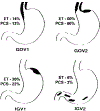Randomized trials of endoscopic therapy and transjugular intrahepatic portosystemic shunt versus portacaval shunt for emergency and elective treatment of bleeding gastric varices in cirrhosis
- PMID: 25957003
- PMCID: PMC6370460
- DOI: 10.1016/j.surg.2014.12.003
Randomized trials of endoscopic therapy and transjugular intrahepatic portosystemic shunt versus portacaval shunt for emergency and elective treatment of bleeding gastric varices in cirrhosis
Abstract
Importance: Bleeding esophageal varices has been studied extensively, but bleeding gastric varices (BGV) has received much less investigation. However, BGV has been reported in ≤ 30% of patients with acute variceal bleeding. In our studies of 1,836 bleeding cirrhotics, 12.7% were bleeding from gastric varices. BGV mortality rate of 45-55% has been reported. The BGV literature has mainly involved retrospective case reports, often with short-term follow-up.
Objective: We sought to describe the results of a prospective, randomized, controlled trial (RCT) in unselected, consecutive patients with BGV comparing endoscopic therapy (ET) with portacaval shunt (PCS; n = 518), and later comparing emergency transjugular intrahepatic portosystemic shunt (TIPS) with emergency portacaval shunt (EPCS; n = 70).
Design, setting, and participants: Initially, our RCT involved 518 patients with BGV comparing ET with direct PCS regarding control of bleeding, mortality rate, and disability. When entry of patients ended, the RCT was expanded to compare emergency TIPS with EPCS (n = 70). This RCT of BGV was separate from our other RCTs of bleeding esophageal varices.
Interventions: Initially, ET was compared with PCS. In the second part of our RCT, emergency TIPS was compared with emergency PCS (EPCS).
Main outcome measures: Outcomes were survival, control of bleeding, portal-systemic encephalopathy (PSE), quality of life, and direct costs of care. In the RCT of ET versus PCS, 28 and 30%, respectively, were in Child class C. In the expanded RCT of TIPS versus EPCS, 40 and 41%, respectively, were in Child class C. Permanent control of BGV was achieved in 97-100% of patients treated by emergency or elective PCS, compared with 27-29% by ET. TIPS was even less effective, achieving long-term control of BGV in only 6%. Survival rates after PCS were greater at all time intervals and in all Child classes (P < .001). Repeated episodes of PSE occurred in 50% of TIPS patients, 16-17% treated by ET, and 8-11% treated by PCS. Shunt stenosis or occlusion occurred in 67% of TIPS patients, in contrast with 0-2% of PCS patients.
Conclusion: These results support the conclusion that PCS is uniformly effective, whereas ET and TIPS are not very effective.
Trial registration: ClinicalTrials.gov NCT00820781.
Copyright © 2015 Elsevier Inc. All rights reserved.
Conflict of interest statement
Figures



References
-
- Hashizume M, Kitano S, Yamaga H, et al. Endoscopic classification of gastric varices. Gastrointest Endosc 1990;36: 276–80. - PubMed
-
- Watanabe K, Kimura K, Matsutani S, et al. Portal hemodynamics in patients with gastric varices: a study of 230 patients with oesophageal and gastric varices using portal vein catheterization. Gastroenterology 1988;95:434–40. - PubMed
-
- Evans JA, Delany F. Gastric varices. Radiology 1953;60:40–52. - PubMed
-
- Yasumoto M Clinical observations on 100 cases of gastric varices. Jpn J Gastroenterol 1971;68:721–39.
-
- Sarin SK, Lahoti D, Saxena SP, et al. Prevalence, classification and natural history of gastric varices: a long-term follow-up study in 568 portal hypertension patients. Hepatology 1992;16:1343–9. - PubMed
Publication types
MeSH terms
Associated data
Grants and funding
LinkOut - more resources
Full Text Sources
Other Literature Sources
Medical

